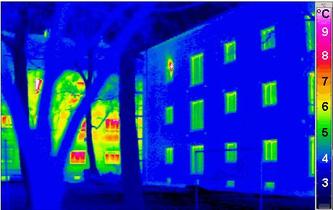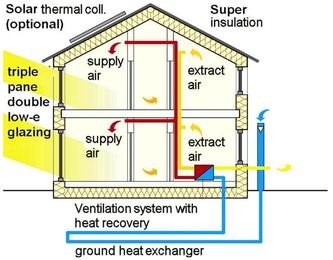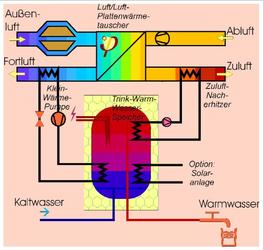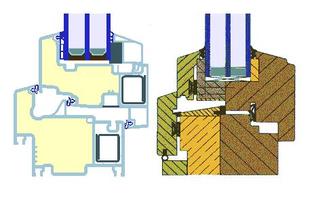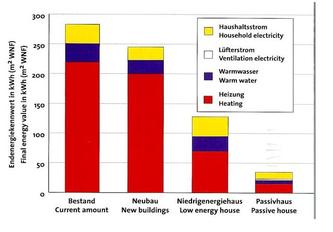Passive House - THE Gold Standard in Home Construction Methodologies!
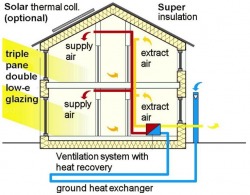
Passive House - THE Gold Standard when it comes to building a new, ultra-green home!
What are the advantages of a Green Tek Haus done via Passive House versus other types of homes? From pictures at bottom of page, or in the videos, let's count the ways:
The four bars (from left to right) compare 4 existing building types built according to old European codes, existing buildings built according to current European codes, low energy buildings of the 1980's and current Passive House homes. The lower the bar, the LESS the energy the building consumes for
(These pictures are from Wikipedia)
climate control, -per square foot, per year.
In other words, (Please view the 30-second videos and pictures below) when a home is constructed in this method, it uses only 10-20% of the energy of a conventionally built new home! Put Solar PVs on the roof of a Passive House home, and now you're talking about making more electricity than you can use! Where there is a Feed In Tariff (FIT) you could actually make money from the excess electricity you could sell back to the grid.
Wouldn't that have a better affect on the Earth AND your pocketbook? This is what we at Green Tek Haus like to call "Double-Green": Good for both the Earth and your pocketbook! While green materials are important, the biggest thing you could do for your new project is to use Passive House know-how to design and build a home that will use 80-90% LESS energy than anything in the neighborhood uses!
This affects the HVAC (Climate Control System) unit size needed for the home, and reduces materials needed, costs, and improves efficiencies. So even though there are more costs associated upfront, there are lower costs in the construction phase that almost off-set those costs. When you factor in the savings over the lifespan of the building, it is huge!
The Energy Benefits of Using Passive House Methodologies to LOWER Energy Consumption
(The last paragraph's Textual Content is from WikiPedia):
In the U.S.A., a house built to the Passive House standard results in a building that requires space heating energy of 1 BTU per square foot per heating degree day, compared with about 5 to 15 BTUs per square foot per heating degree day for a similar building built to meet the 2003 Model Energy Efficiency Code. This is between 75 and 95% less energy for space heating and cooling than current new buildings that meet today's US energy efficiency codes. The Passivhaus in the German-language camp of Waldsee, Minnesota uses 85% less energy than a house built to Minnesota building codes
We at Green Tek Haus are already predicting that Passive House Standard will surpass LEED and even Build It Green in the near future, because of the long-term effect it will have.
LEED and BIG are both great and needed. However, those are addressing mostly materials issues. What about energy usage? What about Zero-Net homes? It does nothing to address that side of the equation. Thus, we believe strongly that it will be a matter of time before it is adopted here in the U.S. New California Green Laws are pushing the state in that direction, whether they knew that or not.
Take a look at the pictures below, and then the videos for a more graphical view of this up and coming building technology!
Green Tek Haus has it all under one roof! This means big savings for you on your project! Contact us for more info today!
What are the advantages of a Green Tek Haus done via Passive House versus other types of homes? From pictures at bottom of page, or in the videos, let's count the ways:
The four bars (from left to right) compare 4 existing building types built according to old European codes, existing buildings built according to current European codes, low energy buildings of the 1980's and current Passive House homes. The lower the bar, the LESS the energy the building consumes for
(These pictures are from Wikipedia)
climate control, -per square foot, per year.
In other words, (Please view the 30-second videos and pictures below) when a home is constructed in this method, it uses only 10-20% of the energy of a conventionally built new home! Put Solar PVs on the roof of a Passive House home, and now you're talking about making more electricity than you can use! Where there is a Feed In Tariff (FIT) you could actually make money from the excess electricity you could sell back to the grid.
Wouldn't that have a better affect on the Earth AND your pocketbook? This is what we at Green Tek Haus like to call "Double-Green": Good for both the Earth and your pocketbook! While green materials are important, the biggest thing you could do for your new project is to use Passive House know-how to design and build a home that will use 80-90% LESS energy than anything in the neighborhood uses!
This affects the HVAC (Climate Control System) unit size needed for the home, and reduces materials needed, costs, and improves efficiencies. So even though there are more costs associated upfront, there are lower costs in the construction phase that almost off-set those costs. When you factor in the savings over the lifespan of the building, it is huge!
The Energy Benefits of Using Passive House Methodologies to LOWER Energy Consumption
(The last paragraph's Textual Content is from WikiPedia):
In the U.S.A., a house built to the Passive House standard results in a building that requires space heating energy of 1 BTU per square foot per heating degree day, compared with about 5 to 15 BTUs per square foot per heating degree day for a similar building built to meet the 2003 Model Energy Efficiency Code. This is between 75 and 95% less energy for space heating and cooling than current new buildings that meet today's US energy efficiency codes. The Passivhaus in the German-language camp of Waldsee, Minnesota uses 85% less energy than a house built to Minnesota building codes
We at Green Tek Haus are already predicting that Passive House Standard will surpass LEED and even Build It Green in the near future, because of the long-term effect it will have.
LEED and BIG are both great and needed. However, those are addressing mostly materials issues. What about energy usage? What about Zero-Net homes? It does nothing to address that side of the equation. Thus, we believe strongly that it will be a matter of time before it is adopted here in the U.S. New California Green Laws are pushing the state in that direction, whether they knew that or not.
Take a look at the pictures below, and then the videos for a more graphical view of this up and coming building technology!
Green Tek Haus has it all under one roof! This means big savings for you on your project! Contact us for more info today!
